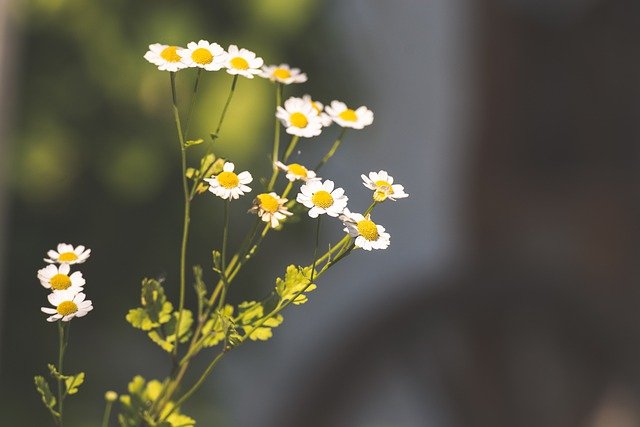
Feverfew, in modern herbal medicine, is mainly used in the prevention and treatment of migraine and menstrual pain. Let’s find out better.
Property of Partenio
Feverfew is known for its anti- inflammatory properties. In particular, feverfew carries out a notable activity against migraines, especially those defined as vasomotor, in which there is an alternation of stimuli on the blood vessels which determines a vasoconstriction and a subsequent vasodilation. This causes a deformation of the walls of the vessels themselves, which thus press on the nearby nerve endings, triggering the pain, which can become more and more excruciating due to the concomitant production of mediators that enhance the pain signal.
The elements of the plant that contain the active ingredients are the aerial parts, especially the leaves, whose balsamic period, in which the concentration of active medicinal substances is maximum, is just before flowering. The main substances contained in feverfew are flavonoids, sesquiterpenes, polyphenols .
Among these, the most important for the medicinal activity of the plant is parthenolide : this substance has the ability to reduce the contraction of smooth muscles and its excitability. This explains the use, since ancient times, of feverfew, which represents a useful remedy for dysmenorrhea and against migraine.
Some studies have also highlighted hypotensive and antispasmodic properties in the digestive tract, again due to the action on smooth muscles. There would also be, as a consequence, a mild tranquilizing effect that would facilitate sleep if the plant is taken in the evening.
Its anti-inflammatory action also has a good soothing effect on joint pain , including those resulting from rheumatoid arthritis.
How to use
In herbal medicine, feverfew is found in the form of an extract and in the form of chewable capsules or tablets. It is used in the prevention and treatment of disorders characterized by pain and inflammation, in particular headache, dysmenorrhea, musculoskeletal disorders.
For all those external treatments that involve rheumatic and muscular pains, you can buy flowers and leaves to make a decoction to be applied on the painful parts or buy directly the soothing creams that contain the active ingredients of the plant.
Since feverfew also has mild properties against anxiety and insomnia, it is sold in capsules that also contain extracts or powders of other medicinal plants that can accentuate the effect against physical and mental agitation and promote sleep.
The leaves of the feverfew are used, with the aerial parts attached. The infusion of feverfew has beneficial hypotensive, digestive and emmenagogical effects. Between July and September the aerial parts of the plant are collected and dried. They are used in the form of a decoction or infusion that is sipped or used to make compresses on painful parts of the body such as skin inflammation or muscle pain.
The bitter taste of feverfew finds its use in some culinary preparations that require a bitter aftertaste. It is mainly used to prepare vegetable soups and soups in general, aromatic omelettes and is also added to fatty meat dishes.
Contraindications of feverfew
Following the intake of feverfew, allergic dermatitis and ulceration of the mucous membranes may appear (in contact with the fresh plant and in predisposed subjects), vomiting, diarrhea, headache, insomnia.
Avoid in case of gastritis, ulcer, hypersensitivity to one or more components. Do not use during pregnancy and lactation.
Not to be confused with Tansy (Tanacetum vulgare , syn. Chrysanthemum vulgare), whose flowers were used in folk medicine as an anthelmintic remedy, now abandoned due to the presence of an essential oil rich in thujone, neurotoxic and abortive.
It is contraindicated in case of taking serotonergic drugs (for example antidepressants). Do not administer to those allergic to composites. Prolonged use is not recommended, the prescription must be made by the doctor.
Description of the plant
Feverfew ( Tanacetum parthenium ) is a plant of the Composite family.
The plant has an erect and pubescent stem and can reach up to 70 centimeters in height. The leaves have a petiole and the flowers are very small and similar to tiny daisies. It is a perennial herb, little cultivated, but often found in the fields. It is about 80 centimeters tall with a pungent and unpleasant odor.
Habitat of feverfew
Like many composites, the feverfew grows spontaneously preferring uncultivated fields and abandoned places. It can be grown for herbal use by arranging it in rows, in furrows that are not too close, because otherwise part of the active ingredients of the plant are lost. Feverfew does not need a particular soil, but it adapts to all types of soil, even stony ones.
Background

Feverfew is a well known plant since ancient times. It is believed to have already been mentioned by Dioscorides (1st century BC) who suggested it for many ailments including, in particular, those characterized by “heat” (inflammation), while Pliny in 79 AD recommended it as a cure for vertigo.
In traditional medicine, feverfew has been used as an aid in the expulsion of the placenta. The twigs of feverfew were placed in the coffins of the dead, as a symbol of guarantee of the immortality of the soul.






